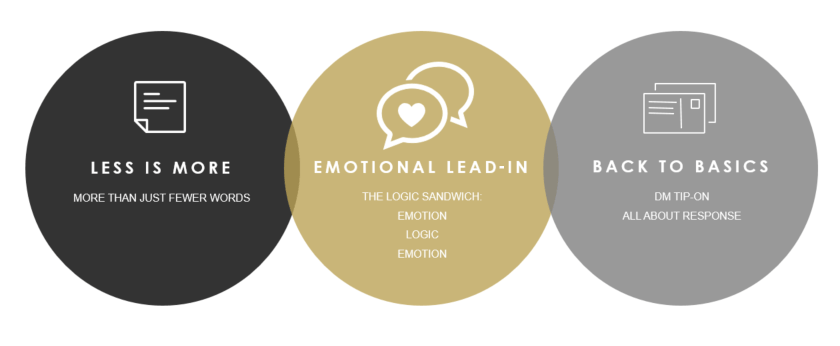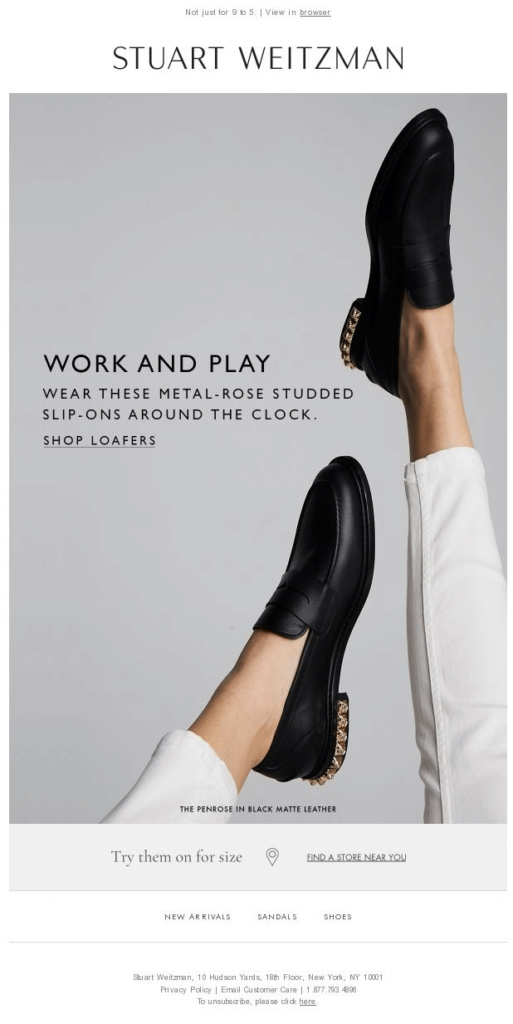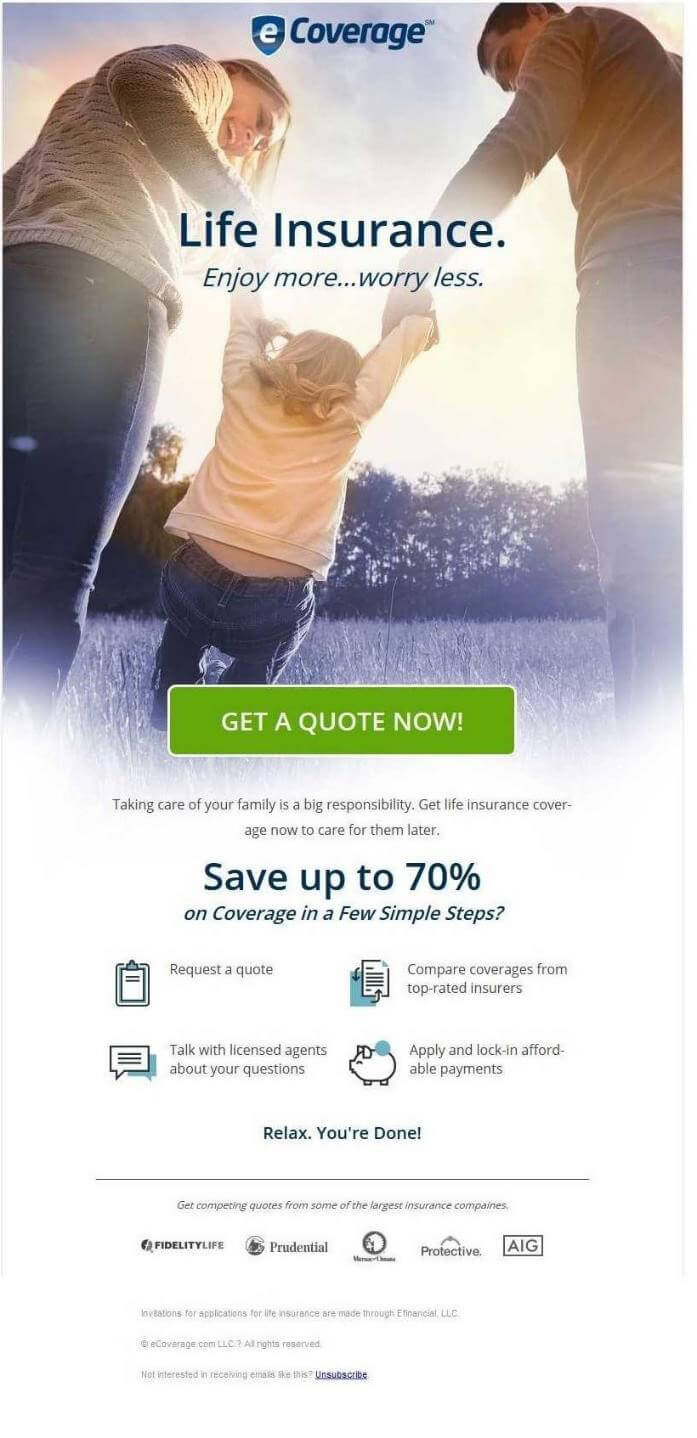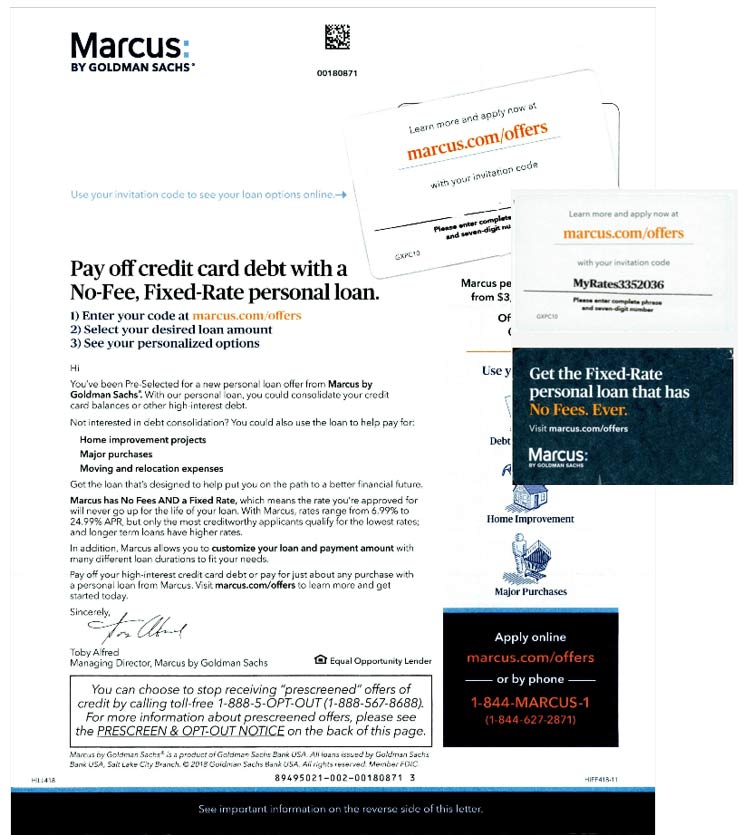SHARE
Back to Basics
At KERN, we periodically ask ourselves, “what’s next?” Summer 2017, there was a heavy focus on what we could do with technology partners and APIs. We spoke to partners like Movable Ink, Iterable and Foursquare to bring together new ways to market our client’s products and services.
As we continue these conversations and create innovative solutions for our clients, it’s important to stay grounded in fundamental elements that we know drive response.
In an industry that’s been disrupted significantly in the past decade, we are now focusing in parallel on those fundamental elements of great DM and Digital communication pieces that simply work. Here are three practices that elicit consumer response:

LESS IS MORE
It’s not just limiting word count and utilizing a good balance of white space. It’s understanding how to stay on brand when the product team is asking marketing to include multiple products on one email, or making all the elements of a digital marketing piece speak to a singular message. Here are two such examples.
Below you will see an extreme case of “less is more” from Stuart Weitzman that makes it clear, in seconds, who the target audience is and what product is being offered, and provides a simple, easy-to-digest use case clearly applicable to the target audience.

One thing that caught our attention was the subtle anxiety Tara felt in making a mistake again, of wasting money. Haven’t we all thought or felt something similar?

Emotional Lead In
Emotionally charged events lead to greater recall. And when it comes to decision making, marrying the rational and the emotional leads to clearer decisions…so why not apply this thinking to marketing? The most effective marketers do, and the most valued partners enable their clients with the right thinking to drive performance with emotional messaging.
In this example from eCoverage, you see great use of leading with emotion, inserting some rational messaging and, lastly, ending the email with an emotional message of “Relax, you’re done.” The image alone defines what insurance should be: security, ease, being held through what could be a challenging process.

I’d like to leave you with this very fundamental practice in direct mail: the tip on. Remember, the purpose of the outer envelope is to get people to open it. That means stimulating the human senses and, if possible, also conveying a sense of need. The tip on does a lot here. It gives the packaging weight and structure, and conveys some mystery as the target prospect wants to know what this firm piece of plastic or cardboard is… maybe a gift card, magnet or fold out?
Can it seem gimmicky? Perhaps. But if executed well, it can be on brand, useful and premium. As used in this Marcus piece, the tip on is useful, generates curiosity and gives a premium feel to a marketing piece (financial product) that is a little formal.

So, when in doubt, remember that appropriate use of space focuses attention, emotional lead-ins capture attention and making use of back-to-basics tactics like a tip on will always generate curiosity.
Back to Basics
SHARE
At KERN, we periodically ask ourselves, “what’s next?” Summer 2017, there was a heavy focus on what we could do with technology partners and APIs. We spoke to partners like Movable Ink, Iterable and Foursquare to bring together new ways to market our client’s products and services.
As we continue these conversations and create innovative solutions for our clients, it’s important to stay grounded in fundamental elements that we know drive response.
In an industry that’s been disrupted significantly in the past decade, we are now focusing in parallel on those fundamental elements of great DM and Digital communication pieces that simply work. Here are three practices that elicit consumer response:

LESS IS MORE
It’s not just limiting word count and utilizing a good balance of white space. It’s understanding how to stay on brand when the product team is asking marketing to include multiple products on one email, or making all the elements of a digital marketing piece speak to a singular message. Here are two such examples.
Below you will see an extreme case of “less is more” from Stuart Weitzman that makes it clear, in seconds, who the target audience is and what product is being offered, and provides a simple, easy-to-digest use case clearly applicable to the target audience.

One thing that caught our attention was the subtle anxiety Tara felt in making a mistake again, of wasting money. Haven’t we all thought or felt something similar?

Emotional Lead In
Emotionally charged events lead to greater recall. And when it comes to decision making, marrying the rational and the emotional leads to clearer decisions…so why not apply this thinking to marketing? The most effective marketers do, and the most valued partners enable their clients with the right thinking to drive performance with emotional messaging.
In this example from eCoverage, you see great use of leading with emotion, inserting some rational messaging and, lastly, ending the email with an emotional message of “Relax, you’re done.” The image alone defines what insurance should be: security, ease, being held through what could be a challenging process.

I’d like to leave you with this very fundamental practice in direct mail: the tip on. Remember, the purpose of the outer envelope is to get people to open it. That means stimulating the human senses and, if possible, also conveying a sense of need. The tip on does a lot here. It gives the packaging weight and structure, and conveys some mystery as the target prospect wants to know what this firm piece of plastic or cardboard is… maybe a gift card, magnet or fold out?
Can it seem gimmicky? Perhaps. But if executed well, it can be on brand, useful and premium. As used in this Marcus piece, the tip on is useful, generates curiosity and gives a premium feel to a marketing piece (financial product) that is a little formal.

So, when in doubt, remember that appropriate use of space focuses attention, emotional lead-ins capture attention and making use of back-to-basics tactics like a tip on will always generate curiosity.
Back to Basics
SHARE
At KERN, we periodically ask ourselves, “what’s next?” Summer 2017, there was a heavy focus on what we could do with technology partners and APIs. We spoke to partners like Movable Ink, Iterable and Foursquare to bring together new ways to market our client’s products and services.
As we continue these conversations and create innovative solutions for our clients, it’s important to stay grounded in fundamental elements that we know drive response.
In an industry that’s been disrupted significantly in the past decade, we are now focusing in parallel on those fundamental elements of great DM and Digital communication pieces that simply work. Here are three practices that elicit consumer response:

LESS IS MORE
It’s not just limiting word count and utilizing a good balance of white space. It’s understanding how to stay on brand when the product team is asking marketing to include multiple products on one email, or making all the elements of a digital marketing piece speak to a singular message. Here are two such examples.
Below you will see an extreme case of “less is more” from Stuart Weitzman that makes it clear, in seconds, who the target audience is and what product is being offered, and provides a simple, easy-to-digest use case clearly applicable to the target audience.

One thing that caught our attention was the subtle anxiety Tara felt in making a mistake again, of wasting money. Haven’t we all thought or felt something similar?

Emotional Lead In
Emotionally charged events lead to greater recall. And when it comes to decision making, marrying the rational and the emotional leads to clearer decisions…so why not apply this thinking to marketing? The most effective marketers do, and the most valued partners enable their clients with the right thinking to drive performance with emotional messaging.
In this example from eCoverage, you see great use of leading with emotion, inserting some rational messaging and, lastly, ending the email with an emotional message of “Relax, you’re done.” The image alone defines what insurance should be: security, ease, being held through what could be a challenging process.

I’d like to leave you with this very fundamental practice in direct mail: the tip on. Remember, the purpose of the outer envelope is to get people to open it. That means stimulating the human senses and, if possible, also conveying a sense of need. The tip on does a lot here. It gives the packaging weight and structure, and conveys some mystery as the target prospect wants to know what this firm piece of plastic or cardboard is… maybe a gift card, magnet or fold out?
Can it seem gimmicky? Perhaps. But if executed well, it can be on brand, useful and premium. As used in this Marcus piece, the tip on is useful, generates curiosity and gives a premium feel to a marketing piece (financial product) that is a little formal.

So, when in doubt, remember that appropriate use of space focuses attention, emotional lead-ins capture attention and making use of back-to-basics tactics like a tip on will always generate curiosity.
